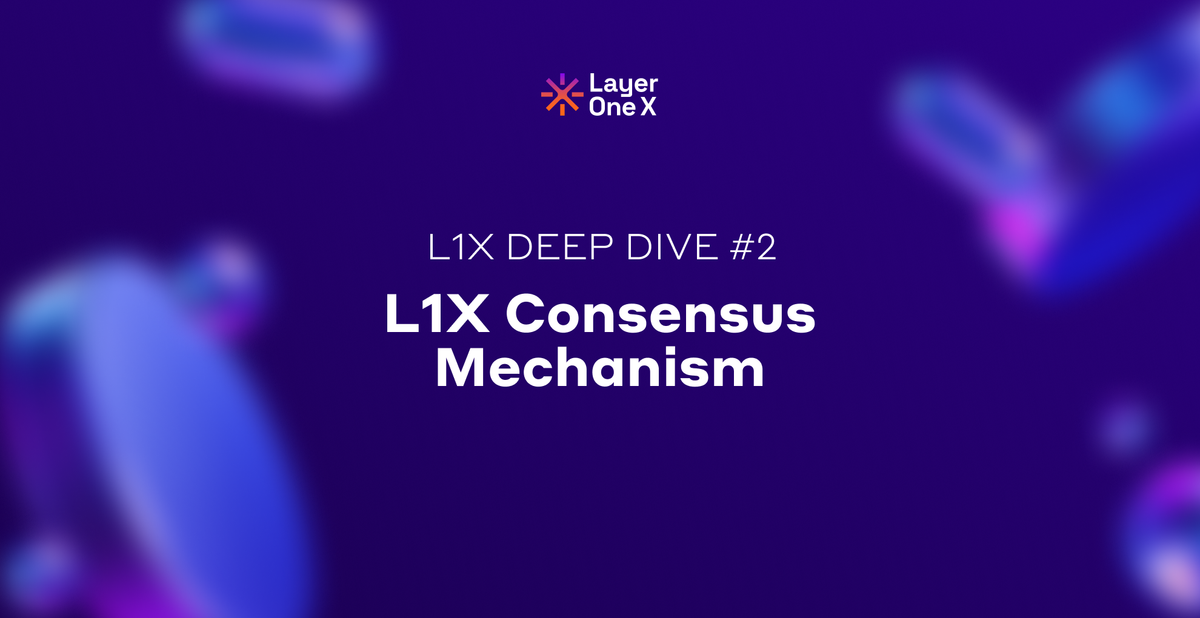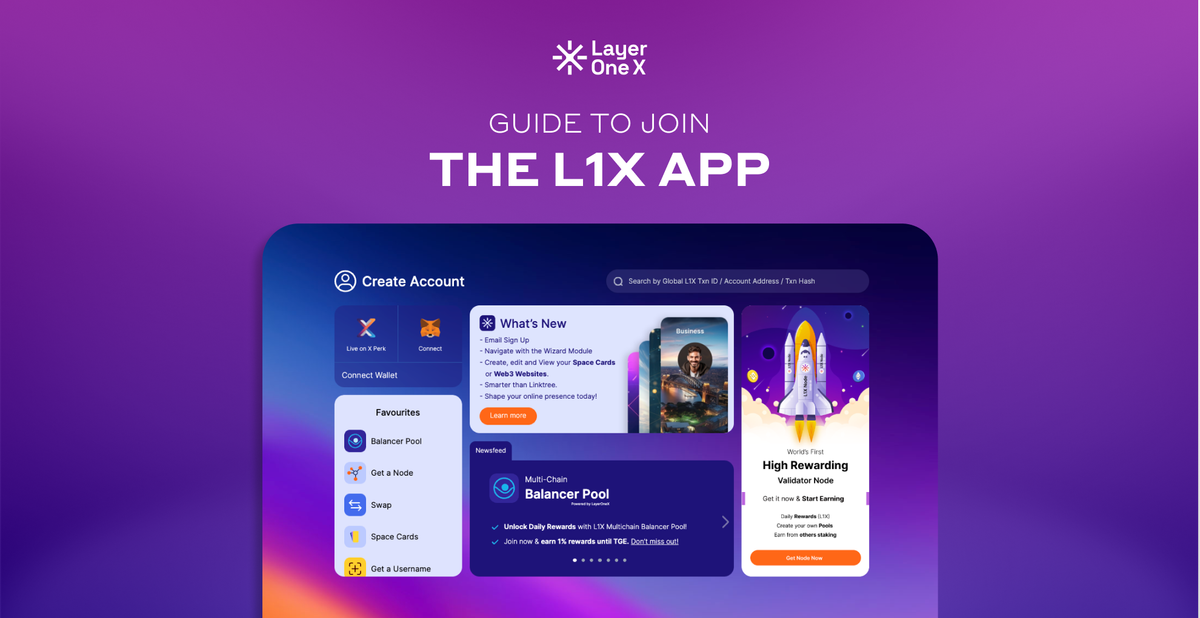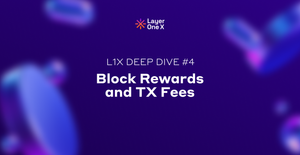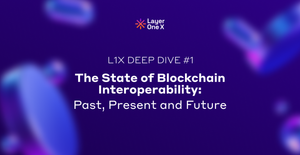Welcome back to Episode II of our L1X Deep Dive Series.
On Friday 8th of March, we delved into the heart of Layer One X's consensus mechanism with Kevin Coutinho, and Dr. Neeraj, expert blockchain researcher on L1X.
From network architectures to smart contracts, we're dissecting the intricacies of L1X's approach to blockchain interoperability.
So, grab your notepads and prepare for an insightful journey through the inner workings of L1X.
WATCH FULL AMA
Section 1. Unveiling the L1X Consensus Mechanism: A Comprehensive Presentation by the Community
We were honoured to have Kevin and a distinguished guest, Dr Neeraj, an expert Blockchain researcher, who played a pivotal role in shaping the white paper and working with the team on blockchain interoperability. The presentation delves into various aspects such as the Proof of X network architecture, consensus mechanism, node types, transaction lifecycle, and more. The goal is to offer a thorough grasp of Layer 1X, highlighting its multi-chain capabilities and native Oracle system.
Section 2. Decoding the Architecture of the L1X Proof of X Network
The discussion in this video section revolves around the architecture of the Proof of X Network and how it addresses key challenges in blockchain, like scalability, security, decentralization, and interoperability. The network uses a sharding strategy to organize data efficiently. It comprises event listener nodes, which act as oracle systems, and full validator nodes, ensuring smooth transactions and contract transfers. Additionally, the X-Talk node facilitates communication between these nodes. Security measures, such as public-private key generation and secure node-to-node communication, are implemented to safeguard the network. Moreover, the network supports an EVM instance, enhancing adoption and flexibility for developers.
Section 3. Exploring Networking Architecture and the POX Consensus Algorithm in L1X
This segment explores two networking architectures: JSON-RPC and gRPC. gRPC, utilizing Protobuf, enhances node communication speed, ease, and security. JSON RPC serves when a website sends transactions to a node. The section delves into the POX consensus algorithm, featuring a randomization algorithm and register to prevent node repetitive selection. The consensus modularity ensures security while allowing method flexibility. Further, the presenter discusses creating a flowchart, "Hash Wire," for consensus code analysis. Transitioning to the POX consensus phase, the focus is on the L1X consensus process. It calculates XScore for validator nodes, considering factors like stake balance, age, participation, response time, and security, determining block proposer eligibility.
Section 4. Parameter Dynamics and XScore Calculation in L1X's PoX Consensus Mechanism
In the section, the significance of parameters in the PoX consensus mechanism for the L1X network is highlighted. Initially, all nodes shared the same node NFT and price. However, factors like stake age and locking period now heavily influence a node's active participation eligibility. Weightages are assigned to different parameters to adapt to evolving network dynamics. Additionally, a fuzzy logic mathematical model is employed to calculate the XScore for each node. The importance of response time in efficiently syncing blocks is emphasized, and a flowchart is presented to illustrate how nodes are chosen as block proposers based on specific criteria such as minimum stake and node NFT.
Section 5. Calculating XScore and Ensuring Fairness: Insights into L1X's PoX Consensus Mechanism
Dr Neeraj discusses how the StakeScore and KinScore are calculated based on specific metrics with assigned weightages. The XScore of a node is then determined using these scores, with a minimum threshold required for a node to participate as a block proposer. Nodes with XScores below the threshold are discarded. Homomorphic encryption is applied to ensure privacy and fairness in selecting block proposers. A randomization algorithm is then used to further ensure fairness in selecting block proposers. This process is part of the PoX consensus mechanism, which aims to provide flexibility and decentralization in the L1X blockchain network. Kevin also briefly mentions the transaction lifecycle and network architecture before discussing the cluster-based mechanism for node responsibilities. The analogy of grocery shopping is used to explain the concept of feature-based sharding and how it helps in executing transactions faster in the network.
Section 6. Clustering for Efficiency: Enhancing Interoperability in the L1X Network
In this part of the video, Kevin discusses the concept of clusters in a network. A cluster is defined as a group of nodes working together, with multiple nodes categorized together forming a cluster. Kevin explains different types of clusters such as the L1X token cluster for token transfers, the L1X contract cluster for executing contracts related to L1X-based tokens, and the X-Talk cluster for event listener nodes. Kevin emphasizes the importance of consensus mechanisms in tying up these clusters to provide interoperability and security in the network. The comparison is made with Ethereum 2.0 Beacon chain and Near Protocol's nightshade consensus in terms of maintaining the most updated state in a decentralized network. Kevin also explains the significance of having different types of contracts (EVM, X-Talk, L1X VM) to cater to different transaction requirements and optimize network performance. The concept of contract instances is introduced to avoid redundant deployments of similar contracts, similar to how one Netflix account can have multiple users without creating separate accounts.
Section 7. Optimizing Storage and Transaction Efficiency in the L1X Blockchain
Kevin discusses how they save on storage space and make it easier for developers to create templates and instances on the blockchain. Kevin explains different contract types, transaction types, and the process of contract deployment, initialization, state changing function calls, and read-only calls. He emphasizes the importance of making storing information on the blockchain cheaper. Kevin also touches on different block types and the decision to have different block types for different transaction styles and contract types. He mentions the need for compatibility between different nodes when syncing superblocks. The video then transitions to Dr Neeraj discussing the transaction life cycle using the example of a multi-chain balancer pool, covering different transaction types like X-Talk, L1X VM, and L1X EVM transactions.
Section 8. Event Emission and Transaction Flow: Navigating the L1X Blockchain Network
In this section, it is discussed the process of emitting events from the client chain to the L1X blockchain network, where listener nodes play a crucial role. Listener nodes store and verify incoming events, schedule them, and handle any necessary formatting before broadcasting them to the network. Once an event is transmitted to the L1X blockchain network, it results in a transaction involving the L1X EVM (L1X Virtual Machine) and the registration of user details and deposits on the network. The Balancer Handler executes the transaction based on its type, such as joining a balancer pool or swapping tokens. The L1X EVM calculates and issues balancer pool tokens to users based on their deposits, with the distribution managed by the liquidity collection register. The transaction flow involves L1X EVM, L1X VM, and X-Talk processes, especially when interacting with different blockchain networks like Ethereum. The importance of database drivers in storing and retrieving data on the blockchain is also highlighted, using analogies like grocery shopping for different family sizes to explain the varying requirements and strategies behind database storage. Different database drivers like RocksDB and Cassandra are mentioned for their specific strengths in handling data storage needs.
Section 9. Efficient Database Sharding and Fee Structure in the L1X Blockchain Network
The section discusses database sharding strategies using Cassandra to store different types of information efficiently. It explains how PostgreSQL ensures atomicity for transactions and can rollback in case of errors. The system uses a combination of PostgreSQL, RocksDB, and Cassandra to cater to various business use cases. The platform allows businesses to share data on the blockchain while keeping it centralized if desired. It supports different database drivers and provides a unified consensus layer for data storage. Developers can interact with the blockchain using a single API, regardless of the underlying database technology. It is also mentioned on the fee structure of the blockchain, highlighting a unified fee system for different contract types and transaction operations. The system verifies fees before processing transactions and calculates fees based on the type of operation being performed.
Section 10. Fee Structure and Reward System: Incentivizing Full Validated Nodes in the L1X Network
In this part of the video, Kevin discusses the fee structure and reward system for Full Validation Nodes in the network. He mentions that developers don't need to worry about fee structures as fees are consolidated into a single source for transactions. He explains that a certain number of Node NFTs will be activated each month, with a target of 80 Full Validation Nodes for April. The block rewards for the month would be 3.33%, resulting in a 40% APR. The number of L1X coins required to host a Full Validation Node has been reduced from 50,000 to 25,000. The rewards for hosting a node are calculated based on the total number of coins staked and the percentage of people hosting nodes. Each node holder can set their commission percentage for the rewards. Kevin also mentions that the hosting cost and hardware requirements should not exceed $100 per month. Overall, the goal is to increase the number of Nodes in the network with reduced coin requirements for hosting.
Section 11. Node Hosting Rewards and Event Listener Nodes: Maximizing Profitability and Security in the L1X Network
In this part of the video, Kevin explains how to calculate rewards for hosting a node using a calculator. Users can input factors such as the number of nodes, expected coin price, probability of circulation, validator commission, and hosting fees to determine potential profits. He emphasizes that even if the coin price decreases, hosting a node can still be profitable. He also discusses the option to accept coins from others to increase node health score. Additionally, Kevin mentions event listener nodes that secure the multi-chain environment and can accept L1X coins, native coins of other chains, and LP tokens for staking. These tokens can be used for cross-chain transfers and bonus rewards. He highlights the importance of liquidity and network security in hosting event listener nodes. Finally, Kevin addresses community questions about using LBP for nodes and providing access to the calculator spreadsheet. L1X suggests waiting for the official calculator release to ensure accuracy.
Section 12. Emission Dynamics, Liquidity Boosting, and Mobile Validation: Navigating the Future of L1X
Kevin discusses the emission for the node decreasing over time, with rewards being lucrative in the adoption phase but potentially dropping after 12 months. He mentions the fees earned by the network and the importance of hosting a node with an NFT. The liquidity provided by the LBP event is discussed, with plans to increase trading volume. Norman Lip is mentioned as a key supporter and investor in the project. He also talks about mobile validation coming after TGE and the availability of wallet SDK for mobile devices.
Section 13. Expanding Horizons: Integrating Solana and Bitcoin, and the Future of WebAssembly in L1X
Kevin discusses the integration of Solana and Bitcoin into their platform, focusing on multi-chain lending and borrowing protocols. L1X aims to showcase Bitcoin as a feature rather than just for swapping, potentially allowing users to store Bitcoin with them and trade with it. Kevin also touches on the bullishness of WebAssembly to eBPF, emphasizing browser-based execution of smart contracts for enhanced security and faster execution. The discussion concludes with a mention of PoX consensus for decentralization and fairness in block proposal selection.
Section 14. Driving Adoption: L1X's Multi-Chain Asset Strategy and Roadmap for Growth
Kevin addresses the topic of adoption and the strategy of multi-chain asset issuance and management. L1X emphasizes the importance of simplifying the process for developers to understand and build on their platform, focusing on a specific powerful feature that sets them apart. Kevin expresses confidence in driving adoption through this feature and research-backed use cases. He also mentions their goal of reaching 800 nodes within 12 months and highlights upcoming updates to their platform, including a new version with enhanced features and user support options.
And that's a wrap on the AMA, folks! We've journeyed through the intricate world of Layer One X's consensus mechanism, uncovering its vital role in driving blockchain innovation.
Did you miss the L1X Deep Dive Episode I. The State of Interoperability: The Past, the Present and Future? Read the Summary Now.
Stay updated on Discord and in our Social Media Channels so you don't miss any important News.
Summaries provided are brief overviews of associated YouTube videos. While we aim for accuracy, they may lack full context. For comprehensive understanding, watch the complete videos.







